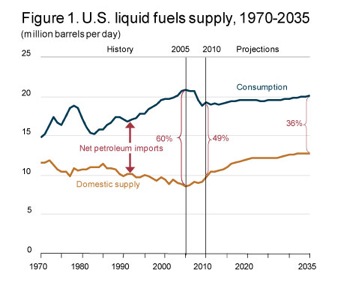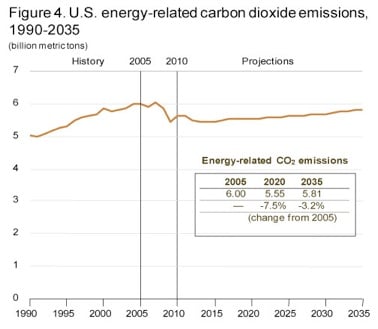Every year, the Energy Information Administration (EIA) prepares an Annual Energy Outlook (AEO) which forecasts energy consumption and demand into the future. In its 2012 Annual Energy Outlook Early Release, EIA makes the following projections[i]:
- EIA is still forecasting a fossil fuel future for the United States with fossil fuels representing 77 percent of energy consumption in 2035, compared to 83 percent in 2010.
- New EPA regulations cause coal-fired generation to decrease its share substantially in the electric generation sector, with increased shares from natural gas-fired and renewable generation.
- Natural gas production increases by 6 trillion cubic feet in the 25 year projection period thanks to hydraulic fracturing technology with the United States becoming an exporter of liquefied natural gas and a net natural gas pipeline exporter.
- Similarly, oil production from onshore lands, mainly privately owned, increases by a million barrels per day by 2020, helping to reduce oil imports from a 49 percent to a 36 percent share by 2035. Like natural gas, this increase is due in large part to shale formations that are accessed with hydraulic fracturing.
- Energy-related carbon dioxide emissions remain below 2005 levels through 2035.
Slow Energy Demand Growth. In its latest energy outlook, EIA expects energy demand to grow slowly at 0.4 percent per year between 2010 and 2035, reflecting a slow economic recovery, higher energy prices, and greater energy efficiency in end-use technologies.
Energy consumption per capita declines by an average of 0.5 percent per year from 2010 to 2035 due to a prolonged economic recovery and improving energy efficiency. Total U.S. population increases by 25 percent from 2010 to 2035, but energy use grows by only 10 percent.
The energy intensity of the U.S. economy, measured as primary energy use per dollar of gross domestic product, is expected to decline by 42 percent from 2010 to 2035 as the result of a continued shift toward less energy-intensive manufacturing and service industries, rising energy prices, and increased energy efficiency. This is a continuation of its historic decline. From 1990 to 2010, for example, energy use per dollar of GDP declined by 1.7 percent per year, primarily because of shifts within the economy away from manufacturing and towards the service sector, which uses relatively less energy per dollar of GDP.
Moderate Petroleum Demand and Production Increases. EIA expects the demand for transportation fuels to be moderated by higher energy prices and Federal corporate average fuel economy (CAFE) standards. Even so, liquids demand increases by almost 1 million barrels per day, from 19.2 million barrels per day in 2010 to 20.1 million barrels per day in 2035. But even at 20.1 million barrels per day, the United States does not reach the liquids demand level of 2007, the year before high oil prices first surfaced and the recession hit.
Domestic oil production also increases from 5.5 million barrels per day in 2010 to 6.7 million barrels per day in 2020, but then declines to 6.1 million barrels per day in 2035. The 2020 forecasted level of production of 6.7 million barrels per day would be the highest level of output in the United States since 1993. Oil production onshore, mostly on private lands in new shale oil deposits, is expected to produce 4.24 million barrels per day by 2020, over 1 million barrels per day more than in 2010. Offshore oil production reaches a peak of 2 million barrels per day in 2020 and then declines with a low of 1.61 million barrels per day by 2030. Because of moderate demand, increased oil production and increased use of biofuels (mostly ethanol), net oil imports decline from 49 percent in 2010 to 36 percent in 2035.
Natural Gas Production and Consumption Increases. Of the fossil fuels, natural gas demand is projected to increase the most, reaching 26.48 trillion cubic feet in 2035, and an increase of 2.35 trillion cubic feet from 2010 levels. In fact, due to horizontal drilling combined with hydraulic fracturing technology, natural gas production is expected to exceed demand, and the United States becomes a liquefied natural gas (LNG) exporter in 2016 and a net pipeline exporter in 2021. Natural gas production is expected to reach 27.84 trillion cubic feet in 2035, over 6 trillion cubic feet more than produced in 2010. Shale gas is expected to account for 49 percent of total U.S. dry gas production in 2035, compared to 23 percent in 2010.
The EIA revised its technically recoverable shale gas estimates downward from those used in its previous outlook. However, geologists are questioning the new estimates, saying companies move gas from unproven resources to proven reserves. According to Greg Wrightstone, vice president of geology at Mountaineer Keystone LLC, companies are driven to prove their resources in order to quickly increase their own value.[ii]
Coal Consumption to Decline in the Near Term. Coal consumption is expected to decline by 128 million short tons between 2010 and 2015 and then increase, reaching 1,155 million short tons by 2035, 104 million short tons more than in 2010. Reduced demand for coal in the early years of the forecast is due to lower coal-fired generation caused by new EPA regulations, causing coal-fired capacity retirements and the addition of new EPA-required equipment that forces most coal-fired units to be offline for at least 18 months. EIA expects 33 gigawatts of coal-fired capacity to retire by 2035, with the majority (29 gigawatts) retiring by 2015. Retired coal-fired capacity is expected to be replaced by natural gas-fired and renewable capacity.
Electricity Generation Continues to Shift toward Natural Gas. The natural gas share of electric power generation is expected to increase from 24 percent in 2010 to 27 percent in 2035 due to lower capital costs for natural gas fired capacity and relatively low natural gas prices due to hydraulic fracturing that enables production of abundant U.S. shale gas resources.
Coal’s share of generation continues its historical decline. Over the next 25 years, the projected coal share of electricity generation falls to 39 percent from 45 percent in 2010, because of onerous EPA regulation, slow growth in electricity demand, continued competition from natural gas, and mandated renewable plants. The new EPA regulations also affect old oil and natural gas steam units. EIA expects 10 gigawatts of those units to retire by 2015 and a total of 21 gigawatts of oil and gas steam units to retire by 2035. IER estimated retirements for just 2 of EPA’s regulations to be almost 30 gigawatts, double EPA’s estimates, which are almost certainly an underestimate.
EIA estimates that 6 gigawatts of nuclear capacity will be retired by 2035 and are replaced by almost 10 gigawatts of new nuclear capacity and 7 gigawatts of increases to existing nuclear capacity. The 6 gigawatts of retirements occur primarily in the last few years of the projection period and result from nuclear plant owners not applying for and/or receiving license renewals to operate their plants beyond 60 years.
The share of renewable energy is expected to grow from 10 percent to 16 percent between 2010 and 2035 mainly because of Federal tax credits and implementation of state renewable portfolio standards that mandate utilities to purchase power from renewable energy sources. All renewable technologies increase their capacity levels, with wind power’s capacity increasing by 72 percent (28 gigawatts) over the 25 year forecast period, solar power’s capacity increasing 500 percent (20 gigawatts), biomass capacity increasing 152 percent (10 gigawatts), geothermal capacity increasing 170 percent (4 gigawatts), and hydroelectric capacity increasing 5 percent (4 gigawatts).
Carbon Dioxide Emissions have peaked. U.S. energy-related carbon dioxide (CO2) emissions have peaked—at least through 2035. EIA projects that energy-related CO2 emissions will total 5,806 million metric tons in 2035, more than 3 percent below the 2005 level of 5,996 million metric tons.
Energy-related carbon dioxide emissions remain lower than 2005 levels despite fossil fuels commanding a 77 percent share of energy consumption in 2035, compared to 83 percent in 2010. Electricity-related carbon dioxide emissions, the highest sector-related emissions, are projected to be tempered by lower anticipated economic growth, higher efficiency standards for end-use appliances, State renewable portfolio standards (RPS), increased natural gas use in lieu of coal, and new environmental regulations targeting coal-fired power plants.
Conclusion
As much as we hear about the rise of renewable energy, coal, oil, and natural gas will continue to provide the lion’s share of our energy for the foreseeable future.
[i] Energy Information Administration, Annual Energy Outlook 2012 Early Release, January 23, 2012, http://www.eia.gov/forecasts/aeo/er/
[ii] Pittsburgh Tribune, Experts question move by feds to hack estimate for Marcellus reserves by 66 percent, January 24, 2012, http://www.pittsburghlive.com/x/pittsburghtrib/business/s_778033.html#ixzz1kOIVlht9





